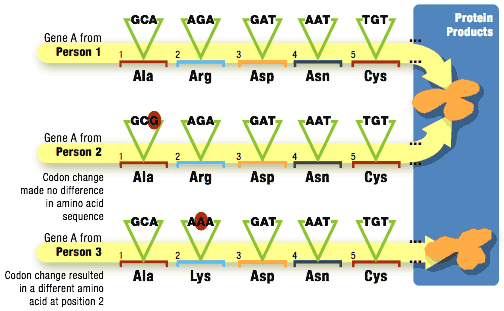|
AN INTRODUCTION TO GENOMICS:
THE HUMAN GENOME AND BEYOND
DNA: Life's Code
The double-stranded DNA (deoxyribonucleic acid) molecule contains the four basic chemical units of life's code: the nucleotide bases adenine (A), guanine (G), cytosine (C), and thymine (T). These combine into the base pairs AT, TA, GC, and CG. The paired bases form the "rungs" of a structure that looks like a twisted rope ladder—the famous double helix. Sugar and phosphate molecules form the outer edges.
Human differences and mutations
The DNA Sequence in every human is 99.9 percent identical to that of every other human. The slight variations in our genomes are called single nucleotide polymorphisms, or SNPs. Scientists estimate that there are about 1.4 million locations on the genome where SNPs occur in humans. It is these small variations that contribute to individual differences. SNPs and other mutations can be caused by copying errors as DNA is reproduced, or triggered by radiation, viruses, or toxic substances in the environment. Many SNPs have no effect on cell function, but others can cause or predispose a person to disease or influence response to a drug.

Translating the code: DNA, RNA, proteins
Following the DNA recipe, our cells manufacture the proteins that are responsible for the structure and functioning of our bodies. Proteins are involved in many of the body's life processes, including growth, repair, digestion, and aging. Many proteins are enzymes that can trigger or accelerate chemical reactions. Others are transporters, such as hemoglobin, found in red blood cells, which takes oxygen from the lungs to the body's cells.
Proteins are produced from the DNA recipe in two basic steps:
1. Transcription
Because DNA never leaves the cell's nucleus, a "messenger" must be created to move its information out into the cell. First, a key enzyme called RNA polymerase makes the DNA unwind and "unzip" by breaking the hydrogen bonds between the bases in the paired strands. This process forms two complementary strands—a coding strand and a template strand. RNA (ribonucleic acid), a single-stranded molecule very similar to DNA, is then created as nucleotide bases are strung together by the RNA polymerase in a sequence determined by the DNA template. The new RNA strand has the same information as the original coding strand, with one exception: U (uracil) nucleotides substitute for the Ts in the DNA. The resulting strand is called messenger RNA (mRNA).
Next, the mRNA travels out into the body of the cell—the cytoplasm—and attaches to a ribosome, the cell's protein factory. Every cell has thousands of these tiny factories.
2. Translation
The As, Cs, Gs, and Us in the mRNA are read by the ribosome as three-letter "words," called codons, which are known as the genetic code: AUG GAA UUC UCG CUC. There are 64 codons, representing the 20 or so amino acids that are the building blocks of proteins. These numbers are not equal because sometimes two or more codons code for the same amino acid. There are also "start" and "stop" codons that determine where the protein chain begins and ends.
Now the ribosome has enough information to manufacture, or synthesize, a protein. The ribosome moves along the mRNA strand and reads its sequence, one codon at a time. With the help of another type of RNA called transfer RNA (tRNA), the ribosome adds amino acids one by one to the growing chain, called a polypeptide chain. When it's complete, the chain folds into a specific shape dictated by the amino acid sequence and becomes a protein; its shape determines the protein's function in the body. The translation process from DNA to protein is complete.
Information taken from the Joint Genome Institute: Joint Genome Institute authored documents are sponsored by the U.S. Department of Energy under Contracts W-7405-Eng-48, DE-AC02-05CH11231, and W-7405-ENG-36. Accordingly, the U.S. Government retains a nonexclusive, royalty-free license to publish or reproduce these documents, or allow others to do so, for U.S. Government purposes. All documents available from this server may be protected under the U.S. and Foreign Copyright Laws and permission to reproduce them may be required. The public may copy and use this information without charge, provided that this Notice and any statement of authorship are reproduced on all copies. JGI is not responsible for the contents of any off-site pages referenced.
Go to next section
Printer-friendly page
All content © 2006-08 by Lori Andrews.
loriandrews.com |
